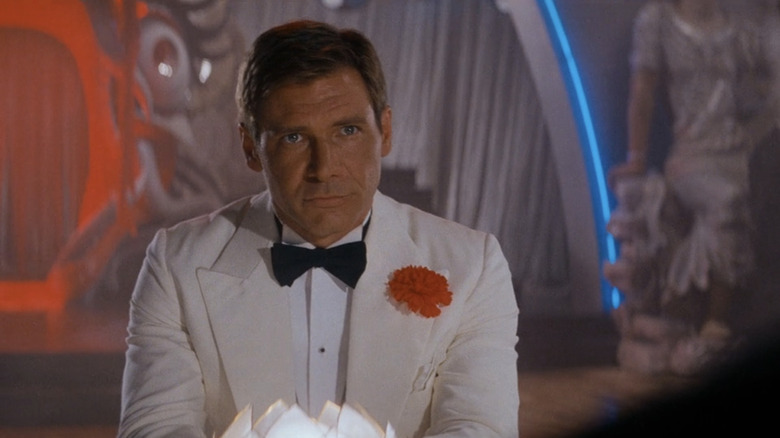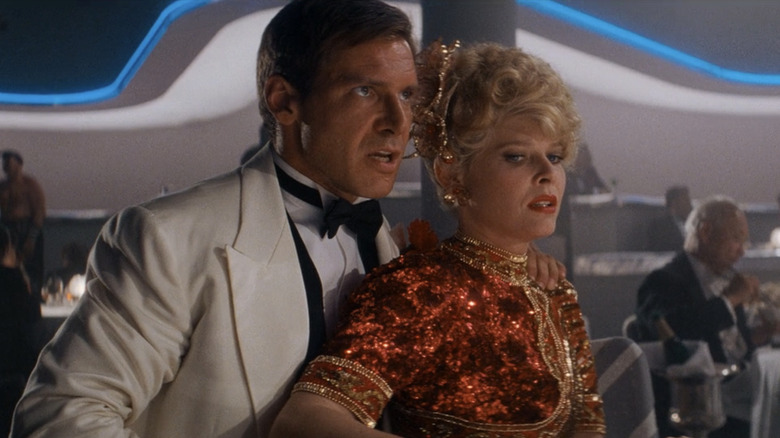George Lucas' Original Concept For Indiana Jones Was More Promiscuous
Indiana Jones debuted in 1981's "Raiders of the Lost Ark," but he took shape almost a decade prior in the mind of George Lucas. Any Indy fan will know that, with Indiana Jones, Lucas was attempting to reimagine the RKO adventure serials he loved as a kid, but there was so much more that went into the creation of the character and his first adventure. Lucas dreamed up Dr. Henry Jones Jr. in 1973, but it would take a while to really define the daring archaeologist. For one thing, the director was busy with a little movie called "Star Wars," but even as he brought his seminal space opera to fruition the idea for Indy persisted, and with the help of several collaborators, finally became the iconic character we all know and love today.
One of those collaborators was Jim Steranko, whose original concept art for 1981's "Raiders of the Lost Ark" depicted a muscle-bound Indy more akin to the super macho action heroes that would come to dominate the decade in which he debuted than the version ultimately portrayed by Harrison Ford. Otherwise, Lucas had the help of his longtime friend and "Raiders" director Steven Spielberg, who came to define so much of what we think of when we think of Indiana Jones. There was also writer Lawrence Kasdan, who penned the "Raiders" screenplay by masterfully filling in the gaps between Spielberg and Lucas' ideas for set-pieces. But there was one collaborator who isn't mentioned as much even though he's responsible for some major changes to Lucas' original vision: Philip Kaufman.
Another longtime friend of Lucas, Kaufman met with the "Star Wars" creator for three weeks in 1975 and during that time came up with some major ideas that would end up in "Raiders." For one thing, it was his idea to have the Ark of the Covenant be the film's MacGuffin, but he also made some changes to Lucas' original concept for the character, most notably by making him less of a roguish lothario.
Indiana Jones was originally a night club-dwelling womanizer
Indiana Jones is the result of combining extensive influences, from Humphrey Bogart's Fred C. Dobbs in "Treasure of the Sierra Madre" and Charlton Heston's Harry Steele in 1954's "Secret of the Incas," to James Bond himself. In fact, Steven Spielberg's Indy movies are basically the director's homage to 007 (though he'd already snuck a Bond Easter egg into "Jaws"), with the movies borrowing all sorts of tropes and ideas from Britain's greatest spy. In 1984's "Indiana Jones and the Temple of Doom," there's even a direct homage to 1964's "Goldfinger," with Harrison Ford donning the same cream tuxedo and red flower lapel as Sean Connery's spy from the opening segment of the third Bond movie. In the sequence, Indiana Jones visits Shanghai's Club Obi-Wan before making a quick escape alongside Willie Scott (Kate Capshaw) and Short Round (Ke Huy Quan). As it happens, this night club-dwelling version of Indy with an attractive blonde on his arm wasn't just a nod to 007 but represented something much closer to the version of the character originally envisioned by George Lucas.
It seems during Lucas and Philip Kaufman's 1975 meeting, the latter suggested a change to Indy that would actually make him a little less like Bond. The writer and filmmaker, who's known for 1979's "The Wanderers" and the 1978 remake of "Invasion of the Body Snatchers" among many other projects, had some big ideas for Indy. According to Richard Schickel's 1981 Time review of "Raiders of the Lost Ark," Lucas' original concept was of a rich womanizing playboy but Kaufman stepped in and scaled back that element of the character. As Schickel tells it, Indiana Jones was originally a college professor who would spend his nights in clubs with "slinky, '30s-style blonds" on each arm. But when Kaufman got involved, all of that was removed.
Changing George Lucas' original idea was the right call
After Philip Kaufman made his changes to George Lucas' concept, Indiana Jones would go through several more major changes before he became the character we recognize today. Before he was even confirmed as director, Steven Spielberg changed the character's last name from Smith to Jones, and while Lucas originally wanted Kaufman to direct, the filmmaker was already committed to the 1976 Western "The Outlaw Josey Wales." Even after Spielberg was handed the gig, Indiana Jones underwent multiple changes. For one thing, Tom Selleck was originally cast and perfectly captured the macho adventurer envisioned in Jim Steranko's artwork. When Selleck had to exit "Raiders" it prompted rushed redesigns for Harrison Ford, who further evolved the character into more of an everyman hero.
All of that added up to create one of the most successful and culturally impactful pop culture figures of the 20th century. Would that be the same if Kaufman never tried to tame Indy's womanizing? It certainly would have allowed Spielberg to further indulge his love for James Bond but it also could have worked against the everyman charm that Ford brought to the table. As such, making Indy even closer to the Bond persona would have likely been one homage too far. Ford's projected the sense that Indy was miraculously escaping certain death by sheer luck, which was part of what made the character unique despite his multiple influences, and making him some sort of womanizing nightclub deviant seems like it would have undermined that aspect.


